Faster Than My Brother (Live Solo)
Live studio recording of the synth solo featured on “Faster Than My Brother” from Doctor Body. (@doctorbody) Look for the upcoming album in the early spring of 2024.
Live studio recording of the synth solo featured on “Faster Than My Brother” from Doctor Body. (@doctorbody) Look for the upcoming album in the early spring of 2024.
Mixing it up with the Groove Synthesis 3rd Wave, Moog Matriarch, and the unstoppable Yamaha CS-30. After pushing the AX80 to its outer limits to discover its unique personality quirks, I wanna know if Akai’s first synthesizer from 1984 can lead a pack of notoriously HUGE instruments.
And there’s only one way to find out…
Is the Akai AX80 a handsome but boring instrument? Not so fast.
This gorgeous brute has mastered things other synths can’t touch. Simply put, the AX80 has a strong personality. But to find it, you’ll have to push it to the outer limits of what the engine was built to do.
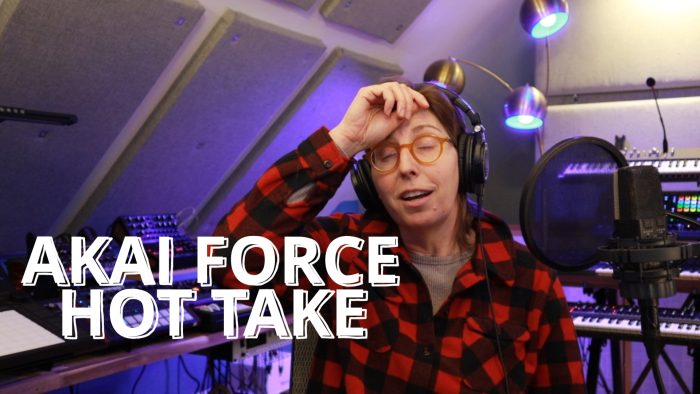
After literally years of thinking, “Hmm, I should make some videos” and then proceeding to do everything BUT make videos, I made some videos. Here they are:
When I decided to finally sit down and do this, I made one rule for myself: I would NEVER create a thumbnail with a crazy look on my face and a giant attention-grabbing headline in a goofy font.
So what’s the FIRST thing I did???
But seriously, these were quite fun to make, and I think I’ll enjoy having them down the road. Who knows, maybe I’ll do some more!
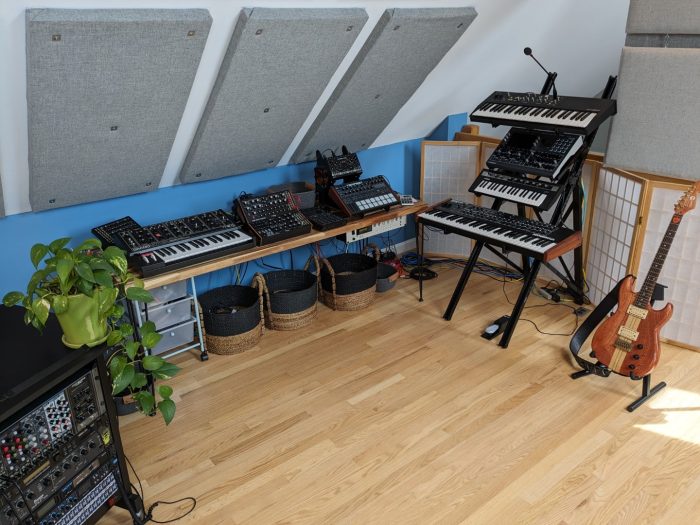
After focusing on the Blix Byrd show that happened last weekend at Nova Arts, I’m now able to turn my attention to future music-making. Because that show featured tracks from the last Blix Byrd album, which was very much a super-crafted studio creation, it was tough to put it together in a way that made sense. I’ll post some video soon so you can judge for yourself how it worked. (Thanks a bajillion to Greg Wilder for making it way better with his mad scientist brain and insane keyboard skillz!!)
But the experience made me re-evaluate how I want to make music — and after 12 years of not performing/rehearsing, I was reminded how important real-time music creation is. Without it, you miss some of the best parts of making music. And I realized that I want performing to be part of the process from top to bottom. To that end, I’ve got my studio all re-set for my next round of projects.
The impetus for this re-vamp, which involves just a couple of new pieces of gear, was to cut out the computer from the process until everything is sounding great, and audio is ready to be recorded in very large chunks. So, it’s a bit of a back-to-the-past approach, when the DAW was used as a tape machine instead of a composition tool. There are a few reasons for this:
So I give you my DAW-less setup! Er, DAW-less ’til the very end, when I use the DAW to record audio, mix and master. Let’s not throw the baby out with the bathwater here.
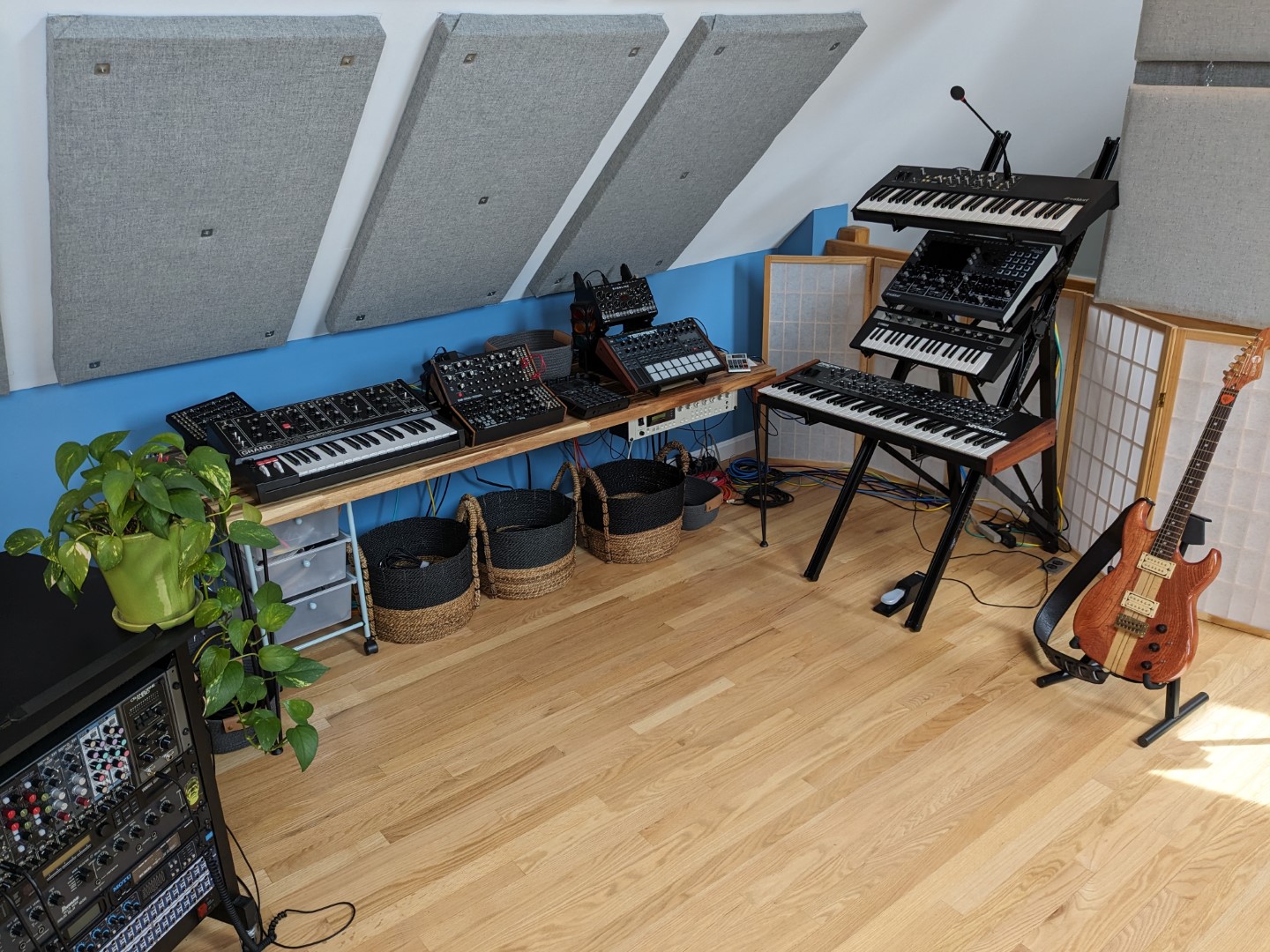
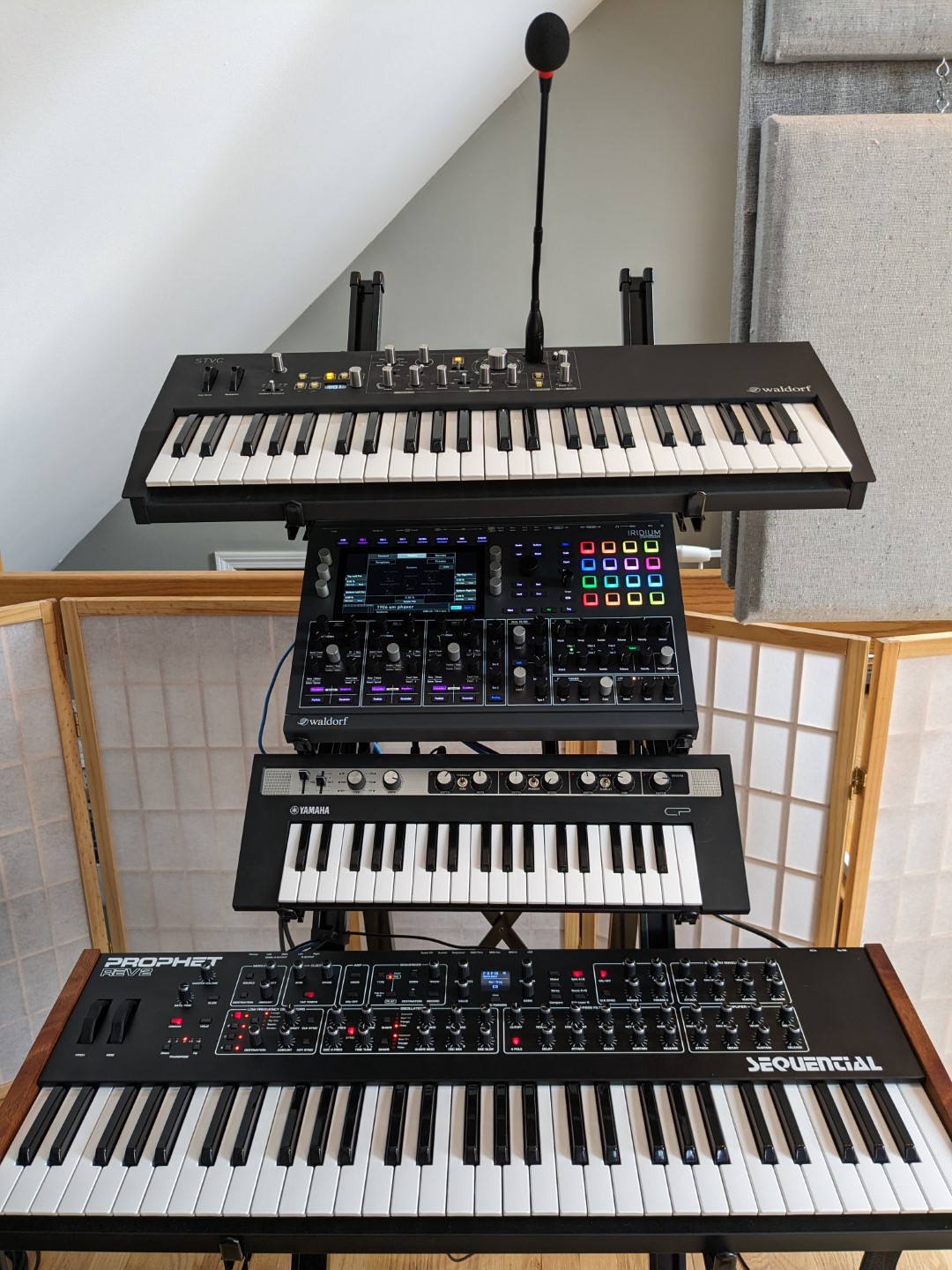
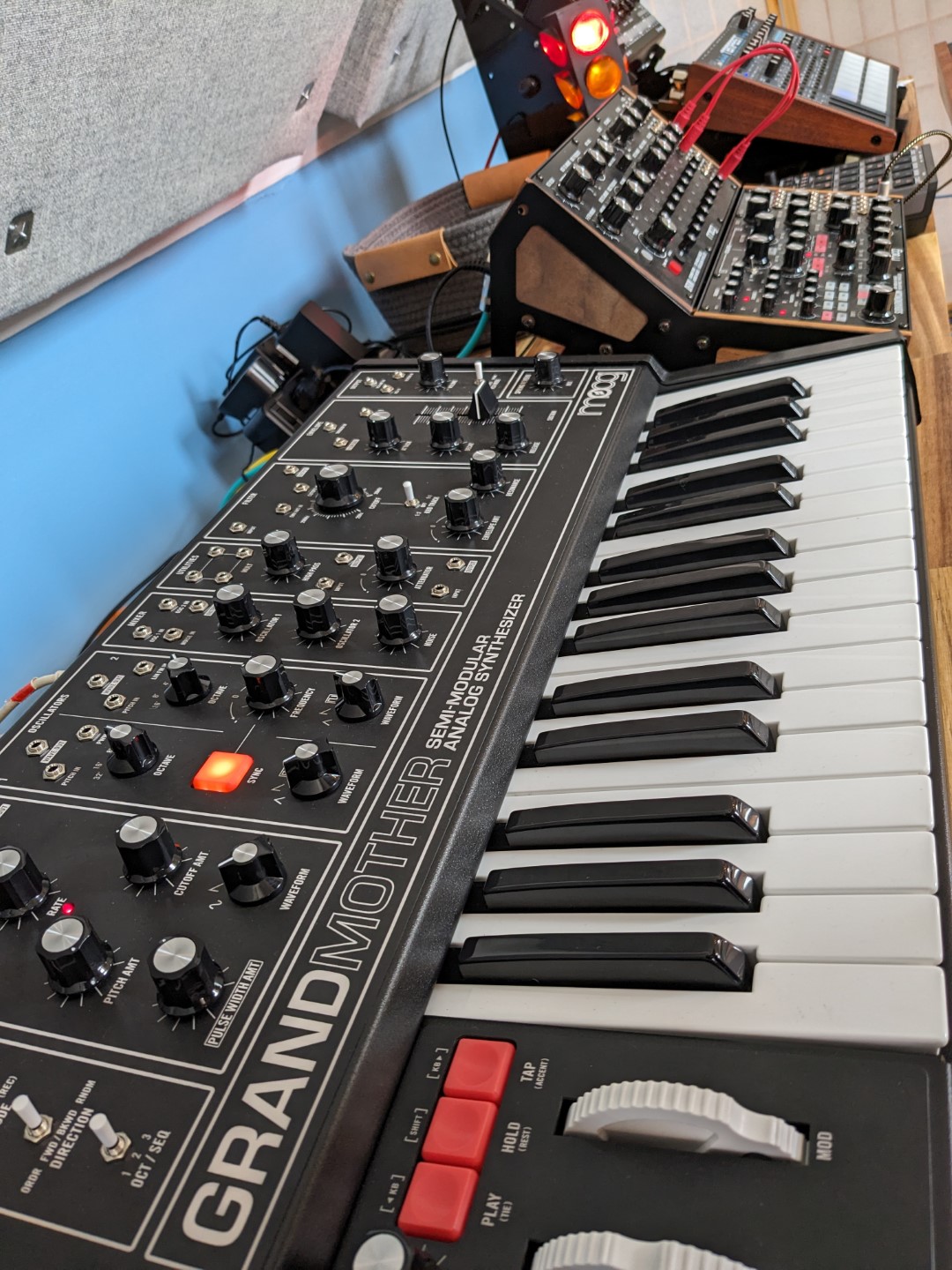
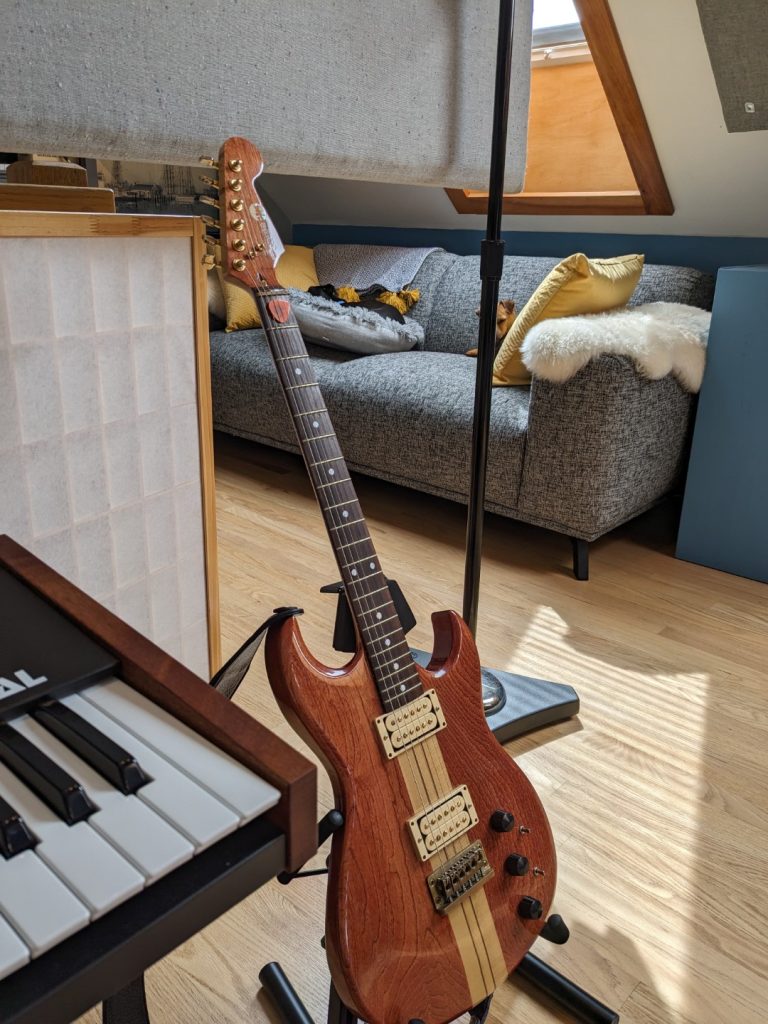
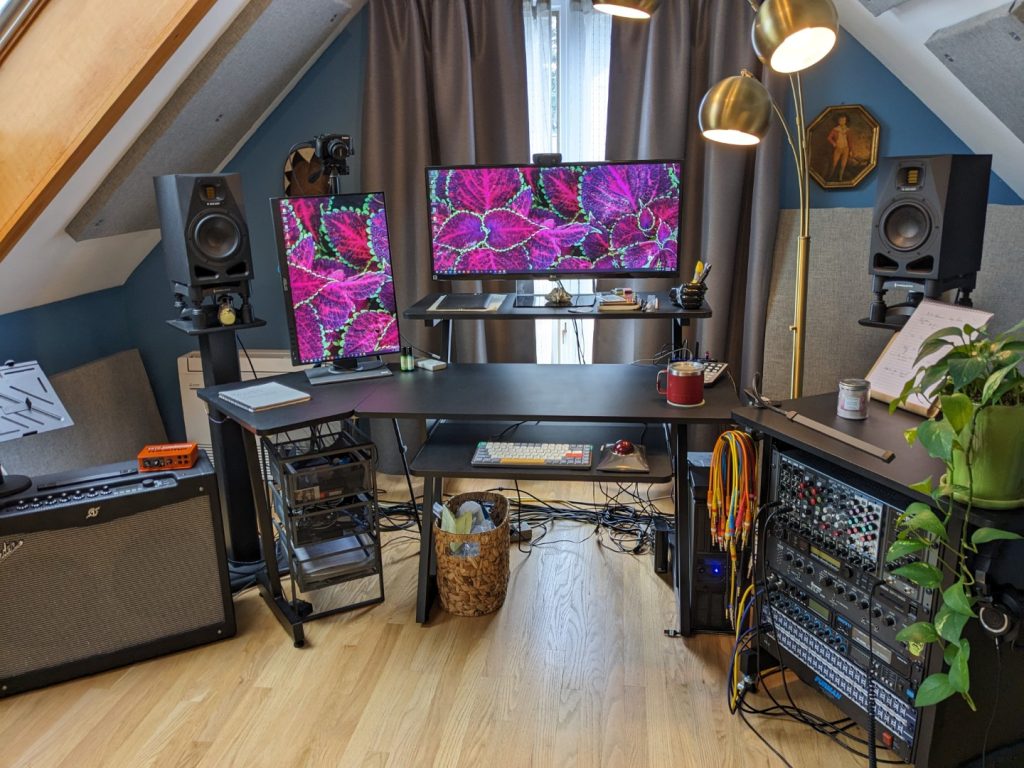
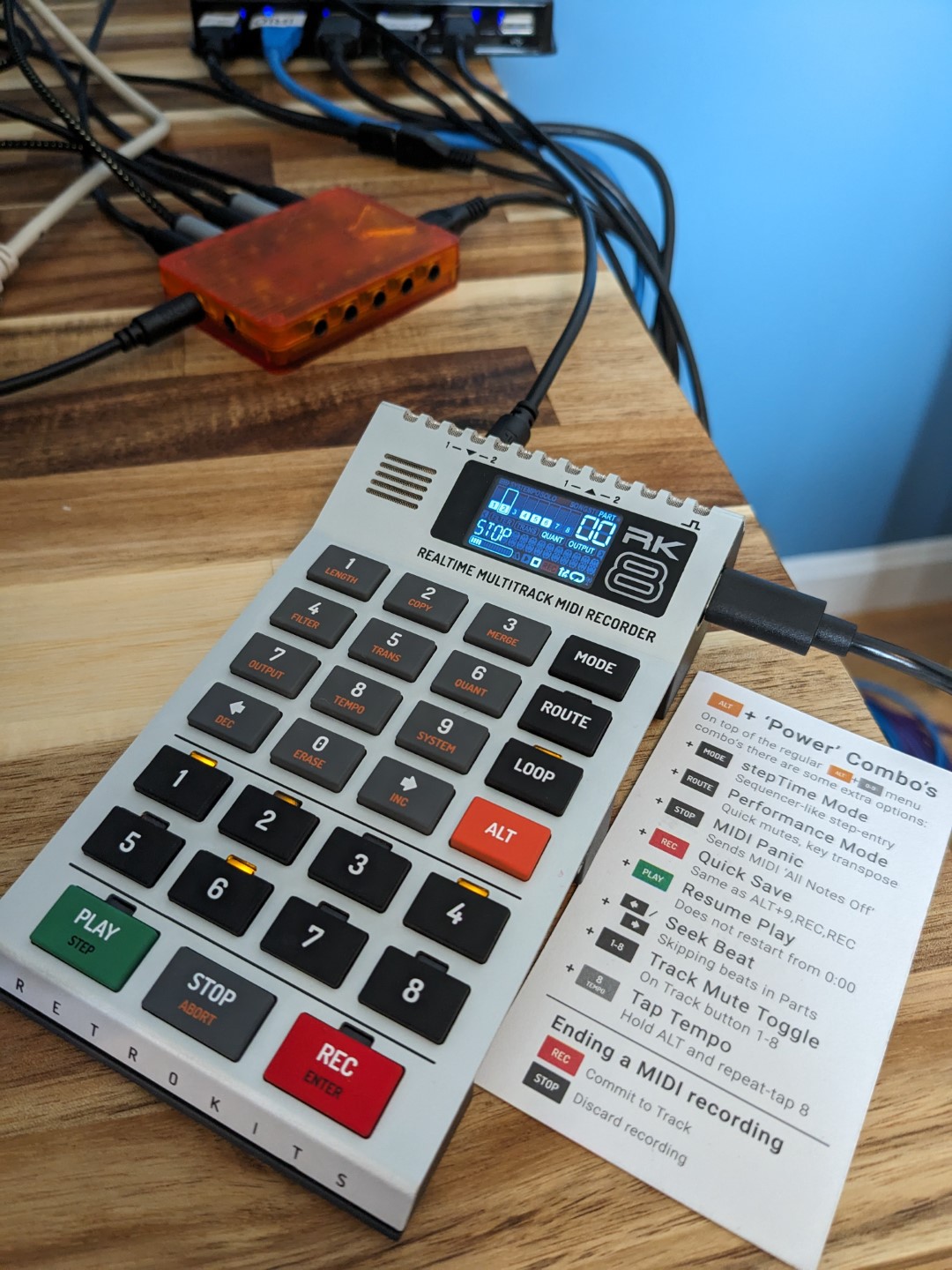
I really couldn’t be more excited about this setup! The few hours I spent making music as I tested everything were an absolute blast, and once I get used to the workflow, I think it will be insanely fun. Here’s to live music-making!!
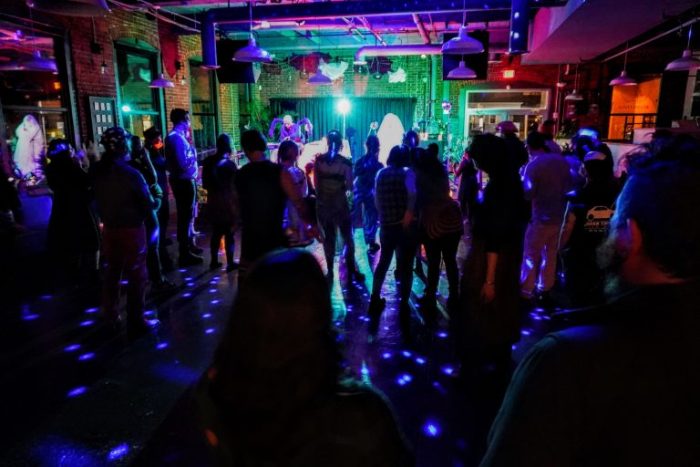
You are cordially invited to come see Alison perform her own music for the first time since 2011. Here’s all the info you could want, and more!
I’m coming, stop talking, just let me buy ticketsBlix Byrd w/ special guest keyboardist Greg Wilder. Stage design by Jess Gelter.
Blix Byrd is Alison Wilder, a multi-instrumentalist, singer and songwriter who crafts bizarre new sonic worlds for each song. Her songs are abstract but narrative-driven, dark but playful, sinister but innocent. She uses a wide variety of instruments, sounds, and styles so that each story lives in its own environment. Alison lives in the beautiful small city of Keene, NH.

Greg Wilder is a composer, pianist, and music informatics specialist who regularly collaborates with choreographers, filmmakers, theater directors and animators on stages across the globe. He’s been at the center of projects ranging from large immersive speaker installations, to touring big band and drag shows, to the development of new music AI technology, to underscoring radio and TV commercials. Today, Greg lives and makes music in a remote cabin in the White Mountains of New Hampshire.
https://gregwilder.bandcamp.com/ | https://gregwilder.com | https://www.youtube.com/@gregwilder

If this looks fun and you’re able to come, I’d love to see you there…the support would be much appreciated! (And if the cover charge is a problem, please reach out, I probably have a list I can put you on.)
Buy Tickets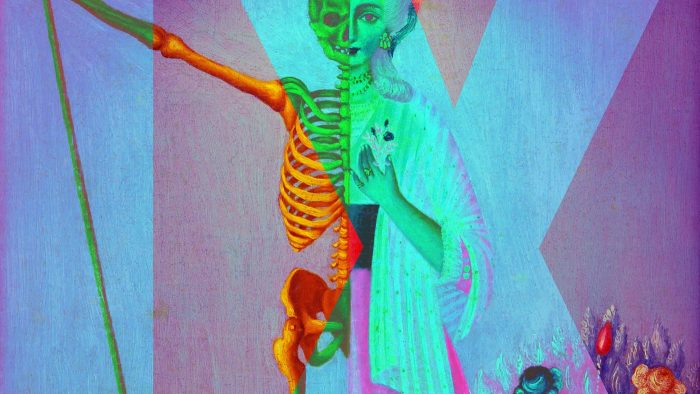
“My Softest Side” started life on acoustic guitar, as so many do. The guitar I was playing that evening was a new acquisition — a Yamaha TransAcoustic, which magically has chorus and reverb effects that require no speakers, no pedals, and no cables. Instead, there’s a little chip that sends signals to a transducer that vibrates the body of the guitar, producing reverb and chorus. WOW.
When I first got this guitar, everything I played on it was sloooow and spaaaceeey, so as to better hear these magical effects. That evening, I was playing some bastardized flamenco at a super-slow tempo, just reveling in the acoustic reverb, and bam, this song was born. (The original demo is about 20bpm slower than the finished version.)
The writing –> production process was pretty standard on this one. My favorite memory of working on it was the day I really connected with the Tempest drum machine for the first time. That day, the Tempest and I produced the bulk of the drum/percussion parts, and we even created the shape of the song form, which was all new for me. (The Tempest is my first drum machine.)
Like most of the songs on IX, this song questions how to relationship. How honest should we be with each other? How much do we, and how much should we know about the person on the other side? Are we really better together? I find these questions relevant to every relationship, but probably even more so to romantic relationships.
The choruses are just me (and this song really is me, I think, more than most songs) admitting and dealing with the fact that these questions don’t have right answers, trying to find a comfortable way to accept that fact, and to be emotionally open anyway.
If I could take a pill to have at hand your memories,
would I? Would I, would I, would I?
If I could suddenly understand your hidden maladies,
would I? Would I, would I, would I?
If I could magically see the writing that you etched in me,
Would I? Would I, would I, would I?
Cause I think what I do not know
can fill a hole with softest cotton
so that when I fall inside
my softest side won’t be forgotten.
If I can sit beside you while I write these words and sing this song,
should I? Should I, should I, should I?
If I can see the pain inside you burning you and know it’s wrong
should I? Should I, should I, should I?
If I can love you through the things I can’t abide and hold my tongue,
should I? Should I, should I, should I?
The moral of the story is,
the story is what I’ve forgotten.
And if you make it to the end,
you’ll find the end is made of cotton.
If I decided I would make you pay for what you did to me,
could I? Could I, could I, could I?
If I wanted only to lie down with you and touch your skin,
could I? Could I, could I, could I?
If I just walked away and tried to make myself a whole new life,
could I? Could I, could I, could I?
The needle’s eye is threaded, but
the thread is simple — made of cotton.
The rich man and the camel ride
on backs of turtles, long forgotten.
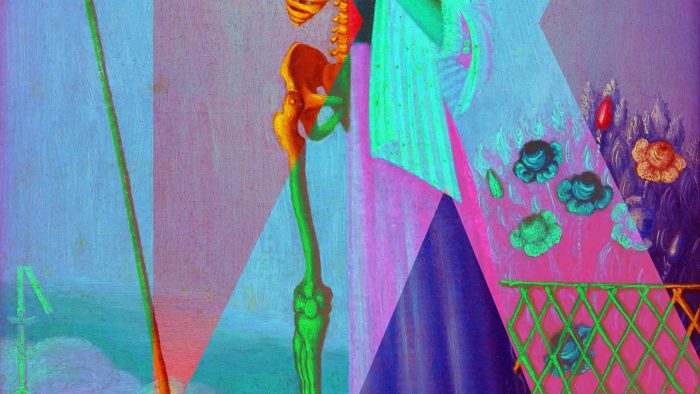
I’ve heard people talk about how a recording can come out fully formed, but I’ve rarely experienced it myself. The album version of the song Enough’s Enough, though, just kind of happened one day. Listening back to the mix I bounced after the first day of recording, it’s shocking how close it is to the final mix. A couple of very minor form changes, a simple synth part, and some added guitars…those are the only real changes and additions after day one. Even the final vocals are from that first day.
I remember very clearly how well things flowed on that particular day. I had been working hard on re-building my studio after my ten-year musical hiatus, and I finally had it in shape, with instruments that inspired me and were easy to access. My signal chain was working. Everything was a-ok.
“I was just right. The day was just right. She was just right.”
Johnny Cash on writing some love song of his, from VH1 Behind the Music w/ Willie Nelson. Sorry I can’t be more specific, I was 16 when I saw it. Why I remember this line so distinctly is a mystery of my brain.
It was also one of the first times I used Ableton in recent years. Ableton’s session view allowed me to spend all day basking in the feel of what I was making, instead of incessantly copy/pasting and/or drawing loops. While I don’t tend to use too many loops in my final arrangements, I find them useful for writing by myself, because I can sit with them, stay immersed, and actually play music with myself.
I’m now using Bitwig + the AKAI Force controller for this type of in-studio writing, but that day in Ableton showed me that clip/loop-based improvising was going to be a great way for me to work in the studio, at least for now.
The verse lyrics weren’t written for the “Enough’s Enough” music at all. They were plucked from some years-old song called Blameless that I’d written and never recorded. The day I made Enough’s Enough (February 14, 2021, aw, Valentine’s Day), I wrote:
Dug through the ole lyrics folder and found that “Blameless” had some gems that worked for the verses. Now it’s a song!
And the chorus lyrics are literally exactly as they were recorded the first time they came out of my mouth in the studio. Sometimes I use a stream of consciousness mumble-mouth technique when I have a musical concept but no lyrical concept. In this case, that stream of consciousness mumble-mouth nonsense just worked for me, and I never changed it or even re-recorded it. From my studio diary:
Recorded scratch vox w/ rando lyrics for one section…it just might work.
Indeed! Delicious!
Another thing that’s so special about this song to me is its function as the seed for the entire IX album. As I listened back to that initial session a few days later, the sound and general approach resonated with me in a very deep way. I thought, “this is what the next Blix Byrd album is.” Although that’s not the real reason it’s the first track on the album, I’m sure some part of me was rooting for it to be track one because it was my track one — the first track that told me I was working on something bigger, something that was going to take awhile, and something I was someday going to be proud to have made.
So what’s the song about? Obviously, that’s for you to decide. 🙂 That said, from my perspective, the singer is sitting at the bar and talking directly to someone they know well. They love and respect their friend, but are bothered by the fact that they incessantly stretch and bend the truth. They’ve never called the person out, and they never will, because every time they start to bring up the issue, they just end up falling back into old patterns and having a great time.
Also, importantly, can thinkpiece be one word? I really hope it can.
First please indulge me in my short little thinkpiece:
the last time you did something wrong,
what shirt were you wearing? Whose drink were you carrying?
Those shots went to my head, and my memories have all drained down.
My memory for faces never has been so good,
but I’m gonna tell you what I know:
I know he was famous cause he had the greatest shoes.
Let’s make this painless, cause you were wrong too.
Enough’s enough enough
I want someone to call my bluff
About this peace and peace and love
Enough’s enough’s enough’s enough’s enough’s enough’s enough’s enough
All right, let’s start again. Let’s get into the thick of it.
Go back to the last time you were not so sure:
Do you remember what that feeling is? Cause I cannot remember it!
Fuck it let’s go, I’ll put on my on my walking shoes!
Enough’s enough enough
I want someone to call my bluff
About this peace and peace and love
Enough’s enough’s enough’s enough’s enough’s enough’s enough’s enough

I couldn’t be happier to put this album into the world. It’s been quite the journey, and I’m both thrilled and a bit sad that it’s over. The blurb:
IX serves as a tall, intricately-carved shrine to Alison Wilder’s songwriting. It combines sparkling synths with menacing guitars, a Texas swagger with an East Coast snarl, earnest singing with robotic voices, and a pop sheen with a deep experimentalism.
The album sees Wilder coping with the difficulty and sublimity of relationships. From the earnest questions of “My Softest Side” (“If I can love you through the things I can’t abide and hold my tongue, should I?”) to the epic album closer inspired by Mike and Walter’s toxic relationship in Breaking Bad (“I made sure you had everything you needed, but I forgot to put aside some for a time when I would need it, so I’ve got none for this fight.”), IX covers a lot of territory. A wide-open, big sky country’s worth of territory.
But listening to IX isn’t a stroll through a grassy meadow. These songs expect you to pay attention, to climb over the barbed-wire fence and walk with the singer, and to enter a world full of stinging and prickly things that’s probably not quite like your own. And as the singer says, it’s a world that’s got less love than freedom in it.
Available on all streaming services and Bandcamp:
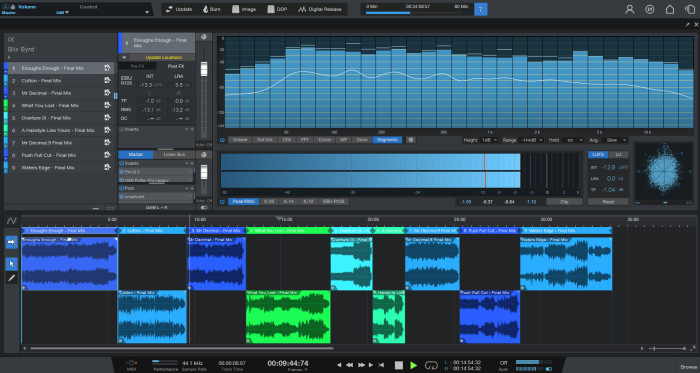
I’m writing this as I wait for bounces to happen in the creation of the final masters for my new Blix Byrd album. It’s a big moment in my life, so I want to do a little live-blogging so I can remember how it feels.
I feel confident at the moment that this album is the best representation of my songwriting up to now. I’ve always made things that are a bit complex given where they’re situated in the world of music (that is, in the pop music realm vs. the art music realm). I think most people who listen to the album will hear this complexity in action. But I LIKE complexity. I like filigree. I like having to listen hard. I like listening to multiple things at the same time. Like, more than two. So that’s how the music I make works.
That said, I’m feeling a clarity of musical purpose in this album that I haven’t felt before. The complexity and intricacy I love so much are present, but to my ears, they don’t distract from the songs. Instead, they’re an integral part of the setting and the meaning of the songs.
The process hasn’t been all roses, though. Once the songwriting and recording processes were over, at every step along the way, I thought, “Wow, I wish I could pass this off to someone else.” This thought kept coming up during mixing, mastering, and album art creation. And even though there are strong arguments to be made for letting experts do those steps, and I could technically afford to hire those things out, I didn’t do it. Why? If I’m 100% honest, I’m not totally sure. I know that I find a sense of satisfaction in there being only one fingerprint on an album, start to finish. (Not withstanding the handful of people who provided feedback along the way and who I appreciate immensely, of course.) I’m not sure this is the right decision, but it’s the one I made.
Wrapping up a big marathon project like this always makes me think about the next thing more than anything else. Finally, I can think new thoughts, give life to new things. Probably like most artists, the “moment of creation” is the best part for me. Defining that moment is tough when you make music like I do, in layers and over long periods of time. It can happen in different spaces, and in different parts of the process. I would define those sublime moments as the ones that tickle that part of my brain that spiritual/religious experiences also activate — the part that makes you feel oneness with the universe, and the sense of connection to something larger than yourself.
I think the part of the process where that creative spirituality takes over the most is during the time when I’m sitting with the guitar or the piano and singing the song for the first time — when it’s actually born. As I said to a therapist once, if I weren’t a songwriter, I’d probably have to get religion, because that feeling is completely necessary for my sense of well-being. So when I’m focusing on finishing, as I have been, I’m missing out on the part that makes me most deeply crave making music in the first place.
When I said there was a strong argument to be made for letting other people do the finishing work, this is really what I meant — if the best part is in the initial creation (mostly the songwriting, and it happens pretty regularly during a creative recording process as well), why not give that piece primacy in my life?
For me, that amazing spiritual songwriting experience isn’t something I can process and appreciate when it happens too often. I go through periods where I write every day, but let’s face it, I’m not 25 anymore. My levels just don’t run as hot as they used to, and I think there’s an advantage to that. For one thing, the ability to run a marathon and finish it with focus and purpose, instead of rushing through the end steps so I can get to the next thing. I appreciate that about my 41-year-old self.
But yeah…the next thing is sounding pretty good about now. 🙂